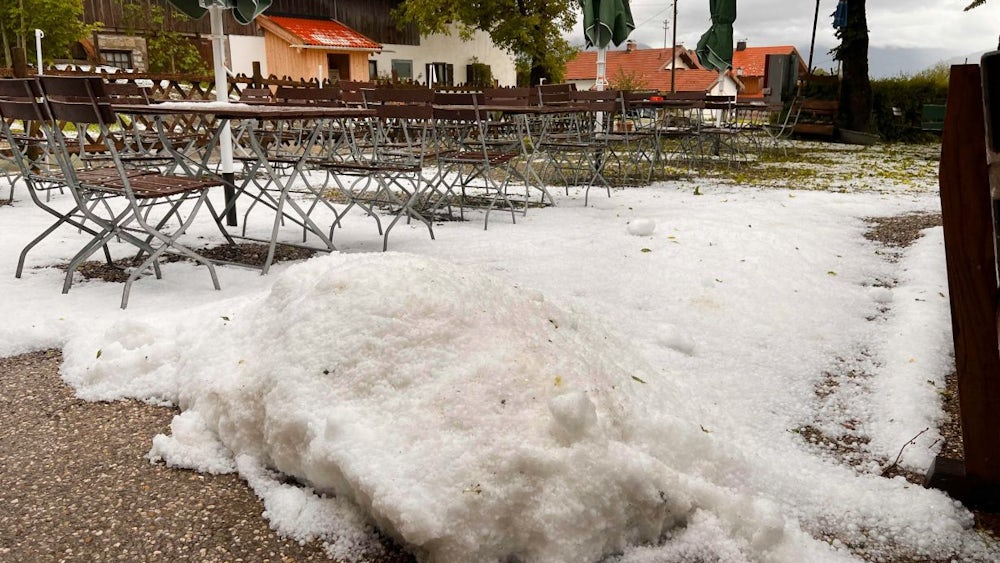The changeable weather conditions with heavy rain and hail, which already hit parts of Bavaria last week, are expected to continue this week, according to the German Weather Service (DWD). Thunderstorms are expected again, moving from Swabia through Upper Bavaria to Lower Bavaria and Upper Palatinate. This will bring heavy rain, hail and gusts of up to 80 kilometers per hour. According to the Bavarian Flood Information Service, flooding and extreme flash floods are possible on Monday, especially in the southwest of the state.
Last week, emergency services had to rescue people and vehicles that could no longer escape from flooded buildings or underpasses. No one was seriously injured, according to the police. But some operations could probably have been avoided: “Most of the people rescued underestimated the danger and thereby contributed to their own situation,” says Matthias Ott, head of the fire service and disaster control department at the Ministry of the Interior.
He advises drivers not to drive into unknown, flooded areas because “if the water is 30 centimeters deep, the car will definitely be broken.” When there is a heavy rain warning, people should also not stay in cellars or basements or near bodies of water. “There are people who go canoeing during floods. That is an unnecessary risk, also for the emergency services.”
Despite the increased number of alarms, the fire departments have coped well, says Ott. “In the Free State, we have a high density of fire stations and are also well positioned in terms of the number of emergency personnel.” Although special equipment may occasionally be missing, this can be compensated for by exchanging material between each other.
“Really good growing weather,” says the agricultural expert
Johann Graf from the Bavarian Farmers’ Association is also optimistic: “It has not rained excessively in most places.” The soil has therefore been able to absorb the water well and now has a good structure. Since it had already become warm in April, farmers were also able to sow potatoes and sugar beets early. After a short break in the rain at the end of April, corn and other crops followed. According to Graf, the weather is currently “really good for growing” as rainy days alternate with sunny ones. Despite this, there was heavy rainfall in some places last week. “It remains to be seen how this will affect the harvest there,” says the arable farming expert.
The fact that extreme weather events in the Free State are quite sporadic is also shown by statistics: If you look at May as a whole in the Free State, the amount of precipitation is below the average for the reference period from 1961 to 1990. “It is not unusual for May to be wet,” says Dirk Mewes of the DWD. What is remarkable, however, is that there were such high amounts of precipitation locally. In some places, it last rained this heavily more than 50 years ago.

Mewes expects that such events will become more frequent in the future. “We expect that the atmosphere will gradually warm up and will therefore be able to store more water.” If clouds form from the saturated air masses and then rain down, the amount of precipitation will also be greater.
Municipalities and cities have different approaches to protecting themselves from possible flooding. For example, the local council of Kastl in Upper Palatinate rejected a protection plan more than 20 years ago. Even a few days after the masses of water washed cars across the market square in the Amberg-Sulzbach district, Kastl’s mayor Stefan Braun stands by this decision: “We would need retention structures that would have to hold back up to 23 square kilometers of water. That would be too much of an intervention in nature.” The buildings at risk of flooding also do not have basements, so nothing happens in the event of minor flooding. And even after last week’s extreme event, the damage was limited.
Instead of building dams, the market town is using a warning app. On Tuesday of last week, the app also sounded the alarm 40 minutes before the flood. “I think a lot of people didn’t take the message seriously or aren’t even in the system,” says the mayor. Residents will now be contacted again to promote the voluntary service. “A few people have already approached us. After last week, everyone is definitely more aware,” says Braun.
People in Bavaria are also more negligent when it comes to insurance coverage than elsewhere. According to statistics from the German Insurance Association (GDV), almost all houses were insured against storms and hail in 2023, a GDV spokeswoman announced in Berlin on Monday. In contrast, only 47 percent of homeowners had insurance against so-called natural hazards such as heavy rain and flooding. The national average, however, is 54 percent.
The frequency of damage to residential buildings has increased. Of 1,000 insurance policies for residential buildings, an average of 27.3 were affected by storm and hail damage (2022: 17.7). Damage caused by heavy rain and flooding was reported 9.5 times last year (2022: 4.5).
According to the insurance company, the total amount of storm damage in Bavaria has also increased significantly. While it was still 700 million euros in 2022, a year later it was already around two billion euros. According to the information, damage to houses, household goods, commercial and industrial companies accounted for around 1.2 billion euros. In addition, there were around 830 million euros for motor insurers.


